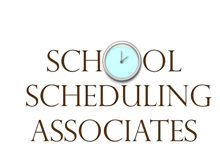Workshops/Consulting
School Scheduling Associates provides a variety of workshops, as well as customized consultations and schedule building. Links to workshop descriptions follow. Click on the “Consulting Calendar” to look for available dates; click on the “Contact” link to request specific services.
Workshops on Innovation in Elementary, Middle and High School Scheduling and Services Related to School Scheduling
The construction of the quality school schedule is essential leadership task. Dr. Michael D. Rettig has 40+ years of experience working with more than 1000 elementary, middle, and high schools in 43 states and internationally in Austria, Bermuda, Canada, Dubai, Germany, The Netherlands, Thailand, Saudi Arabia, Singapore, and the United Kingdom. Dr. Rettig provides workshops for administrators and teachers on school scheduling topics, in addition to consulting with school districts and individual schools regarding the selection and construction of the most appropriate schedule given the district and school context.
Below is a list of Michael D. Rettig’s current workshops. Click on the Title to get a more detailed description.
Workshop 1: Designing Quality Elementary School Schedules: Major Focus on Providing Structured Time for Intervention and Enrichment
Workshop 1: Designing Quality Elementary School Schedules: Major Focus on Providing Structured Time for Intervention and Enrichment
The creation of an effective school schedule is a key component of every elementary principal’s work. While many different personnel should be involved in the process, to delegate this responsibility is to abdicate the role of instructional leader. Based upon 40+ years of experience working in schools across the country Dr. Michael D. Rettig, professor emeritus from James Madison University, founder of School Scheduling Associates, and co-author of Elementary School Scheduling: Enhancing Instruction for Student Achievement (Eye on Education, 2008), will outline problems which have been identified with typical elementary school schedules, related general principles for effective elementary school scheduling, provide a process for creating quality schedules, and share examples and templates. Particular attention will be paid to the following topics:
• Optimal scheduling of “Encore” teachers (PE, music, art, etc.) within and across buildings which provide common planning time for teams of teachers,
• Scheduling and organizing an Intervention/Enrichment during which Response to Intervention tiered instruction may be provided,
• Preserving large blocks of uninterrupted core instructional time for classroom teachers, and
• Scheduling support services (special education, ESOL, reading support, instrumental music, etc.).
In addition during this session Dr. Rettig also will share the basics of parallel block scheduling, a model of school time organization that strives to accomplish the following goals:
• Reduced-size classes for small group reading and mathematics instruction,
• Accelerated literacy acquisition in kindergarten and first grade classrooms,
• Support services such as special education, ESL, talented and gifted which are integrated with the regular school program,
• Options for practice, reinforcement, remediation and enrichment of the regular school program during an “extension” period.
Handouts, sample schedules, and a digital scheduling template (in Excel) will be provided.
Workshop 2: Scheduling Strategies for Middle Schools: Major Focus on Structured Time for Intervention and Enrichment
Workshop 2: Scheduling Strategies for Middle Schools: Major Focus on Structured Time for Intervention and Enrichment
The creation of an effective school schedule is a key component of every middle school principal’s work. While many different personnel should be involved in the process, to delegate this responsibility is to abdicate the role of instructional leader. Based upon 40+ years of experience working in schools across the country Dr. Michael D. Rettig, professor emeritus from James Madison University, founder of School Scheduling Associates, and co-author of Scheduling Strategies for Middle Schools (Eye on Education, 2000) will review a variety of unique middle school scheduling plans. After a discussion of eight key questions that must be answered before creating a middle school schedule, a variety of possibilities will be presented, including the following:
• Six, seven, eight, and nine-period scheduling plans,
• The “4-Block” schedule, a middle school version of the high school 4X4 schedule that provides double periods for both language arts and mathematics,
• A “5-Block” schedule,
• A schedule that provides time and a half in language arts and mathematics instruction in comparison to other subjects,
• A schedule that provides equal and but longer periods (@60 min.) for language arts, mathematics, science and social studies in comparison to other subjects (@ 40 min.),
• Plans appropriate for two, three, four, five, and six teacher teams, and
• Options for delivering exploratory and elective classes.
Special emphasis will be given to designing schedules that included structured time for intervention and enrichment (I/E), which often is necessary for optimal implementation of Response to Intervention. Scheduling and organizational issues related to the I/E period will be addressed in detail.
Handouts, sample schedules, and a digital scheduling template (in Excel) will be provided.
Workshop 3: Trends and Issues in High School Scheduling: Basic Scheduling Structures Revisited, Options for Intervention and Dropout Prevention Explored
Workshop 3: Trends and Issue in High School Scheduling: Basic Scheduling Structures Revisited, Options for Intervention and Dropout Prevention Explored
The creation of an effective school schedule is a key component of every school principal’s work. While many different personnel should be involved in the process, to delegate this responsibility is to abdicate the role of instructional leader. Based upon 40+ years of experience working in schools across the country Dr. Michael D. Rettig, professor emeritus from James Madison University, founder of School Scheduling Associates, and co-author of Block Scheduling: A Catalyst for Change in High Schools (Eye on Education 1995) will focus on high school scheduling possibilities. He will share many different models of scheduling, discuss the pros, cons, costs, and research related to these models, and outline an adoption and implementation process. Schedules to be discussed include the following:
• Six, seven, eight, nine, and ten-period scheduling plans,
• Rotating and drop schedules,
• Alternating day block schedules,
• The 4X4 semester plan,
• The 3X5 trimester plan,
• The flexible modular schedule,
• Hybrid models which combine features of several basic schedules,
• Plans for credit recovery and rescue, which may assist overage and under-credited students.
Special emphasis will be given to designing schedules that included structured time for intervention and enrichment (I/E), which often is necessary for optimal implementation of Response to Intervention. Scheduling and organizational issues related to the I/E period will be addressed in detail.
Handouts, sample schedules, and a digital scheduling template (in Excel) will be provided.
Workshop 4: Scheduling and Organizing a Data-Driven Intervention/Enrichment Period
Workshop 4: Scheduling and Organizing a Data-Driven Intervention/Enrichment Period
In this session the co-author of books on elementary, middle and high school scheduling will demonstrate how to schedule and organize a data-driven Intervention/Enrichment period to provide short-term instructional interventions, longer-term remediation, special services, and enrichment. Options for scheduling the period in elementary, middle and high school schedules will be provided. Significant time will be spent exploring the organization of this period including the following issues: assessment, data analysis, grouping during the period, appropriate interventions and enrichment activities, and progress monitoring. The application of this period to Response to Intervention will be discussed. Handouts and scheduling templates included. This session can be adjusted to focus on just one level of schooling.
Consulting Protocol: How we work with schools and districts
Consulting Protocol: How we work with schools and districts
Our typical pattern of working with a district is something like the following, though we often adjust and adapt this basic plan depending upon the size and specific needs of a district. Keep in mind that changes to elementary school schedules can frequently be made with six to nine months of preparation or less. Major changes to high school schedules generally require a two-year participatory process including a year of learning, study, research, visitations and decision-making and a second year of preparation (see below). Major changes in middle school schedules can follow the elementary or high school model, depending upon the school and district cultures. Everything can be accelerated if the need is great. When working with all levels in a district, K-12, our procedures for working with the district are similar to what follows. Working with only one level or one school follows similar patterns.
Preparation: In preparation for the first visit we send out data collection forms, which ask principals to detail numbers of students and staff and to fill out a questionnaire, which starts them thinking about some of the issues that will be addressed during the first sessions. These documents help us to begin to understand your district.
Visit 1: The first visit is three days: one day is devoted to teaching the basics and intricacies of elementary school scheduling, one day is spent with middle school educators, one day is spent with high school educators. By late morning or early afternoon of each session we begin to morph from teaching and describing quality schedules to applying these concepts to your situation. By the end of the first visit the district often has a pretty good idea as to which direction it wants to proceed at each level.
Visit 2: The second visit generally is two days: one day elementary and one day secondary (half-day middle school and half-day high school). A day would be spent with elementary educators nailing down the details of a district plan. The following issues would be addressed: What are the time allocations for subjects in all grades? What is the encore (specials) rotation? What is the plan for intervention and enrichment? What is the approach to scheduling special services (special education, Title 1, ELL, instrumental music, etc.). How do we share itinerant staff across multiple schools? Generally one school’s fairly complete schedule, which incorporates all of the agreements described above, is constructed by the end of this day.
During the second visit at the high school level we generally delve into the details of a variety of scheduling ideas, which the district has decided, have merit. We often plan out (backwards map) a longer participatory process that might be opened up to a larger group. Again middle schools sometimes follows the elementary plan with more specific agreements being reached with an eye toward earlier implementation or the high school model which is more deliberate.
Visit 3: The third visit(s) is for implementation support. During these sessions we help individual elementary and middle schools (if following the elementary change path) construct their actual schedules within the parameters agreed upon during visit 2. School teams come to a central location. We construct schedules in Excel; we need a projector with a screen that everyone on the team can see clearly. The number of days needed for this support depends upon the number of schools and the depth of support desired. The maximum number of schools an one consultant will work with in any one day is four (90-minute slots plus breaks and lunch); it’s very intense. Sometimes we work with only two per day and occasionally we have the luxury of spending a whole day with one school. The fewer schools with whom we work per day, the more scheduling detail that can be completed for each school.
Participants in the individual planning sessions all should have at least attended the introductory day, otherwise we end up teaching/explaining too much in each session and less is accomplished.
We recommend that a scheduling committee be formed at each school and that these professionals be the participants in the general sessions and school-based schedule creation meetings. Occasionally administrators are more comfortable handling this themselves. It’s a “pay-me-now” or “pay-me-later” proposition; we find it better to involve teachers from the start, although they may be excluded when sensitive personnel decisions must be made. Generally the elementary scheduling committee at each school includes representation from each grade level (or every other grade level), an encore teacher (PE, art, music, etc.), representatives from the various special services provided (SPED, ESOL, Title I, etc.), counselors and administration. It helps if some of the committee members have the “scheduling gene.” At the middle school level the composition is similar with representation from each team and discipline in the core areas, encore representation, special service representation, counselor(s), and administration. Relevant central office personnel also should be involved, especially if they have approval/disapproval power over any chances or control of staffing allocations.
High School Planning Process
As noted above the decision to change the high school schedule often involves a two-year participatory process; it’s a high stakes game rife with controversy. During the first year the district sets goals, analyzes the pros and cons of the current schedule, lays out it hopes for the ideal schedule, learns about and researches the various possibilities, makes visitations, and decides on the model to be adopted. There often is an administrative steering committee that guides this work; this group usually is composed of central office personnel and high school principals. A larger committee including the steering committee, plus representative teachers, counselors, students and parents forms the larger deliberative group.
The steering committee agrees upon a set of non-negotiables (i.e. “Must be cost neutral,” or “Must allow students to earn eight credits per year”), creates the decision-making process, and organizes the meetings, which flow something like this:
Meeting(s) 1: The reasons for and charge to the committee is delivered; the non-negotiables explained. The role of the committee in the decision-making process is made clear and the schedule of meetings is set. Norms for the operation of the group are established. The strengths and weaknesses of the current schedule are identified. Hopes for the ideal schedule are voiced. A matrix of evaluative criteria is established from the strengths and weaknesses of the current schedule and the ideals hoped for. A process for sharing committee work with larger constituencies is agreed upon.
Meeting(s) 2: We work with the group for a day or two presenting scheduling options that fall within the set of non-negotiables. Together we narrow these options to a more limited set of possibilities (5-6). Using the evaluative criteria established above, each option is analyzed by sub groups, who then report out to the larger group. By the end of two days we narrow the options to two or three, which are to be researched in greater depth.
Meeting(s) 3: The committee creates an interview protocol. Visitation teams are created. Visitations are scheduled; other data are collected.
Meeting(s) 4: Visiting committees report out. A recommendation is made.
How many meetings this process takes varies from district to district. Whether or not we are involved after Meeting 2 is variable as well. At the very latest a recommendation for adopting a new high school schedule must be made by early October of the year prior to implementation, preferably the decision is made by the end of the previous academic term. Thus district/schools must backwards map a meeting schedule to coincide with your decision date.
Year two of the high school change process is devoted to preparation, which includes the following:
- Proving the concept. Can you actually build the schedule you have adopted? Do a pilot run using real student course selections.
- Revising curriculum and/or course pacing. If the format/duration/meeting patterns of courses have changed, there is curriculum work to be done.
- Updating registration materials. Course descriptions, guides, forms, etc. must be revised.
- Planning and providing professional development. If the length of class periods/blocks has changed professional development is needed.
- Reviewing and revising school policies. Many school policies are related to the schedule and must be reviewed and revised if needed.
- Devising and implementing a communications plan. All constituencies must be informed of the change and its impact. Hopefully they have been kept informed along the way.
- Evaluation. Plan the evaluation including hoped for results, data collection, data analysis and report PRIOR to beginning the new schedule.



